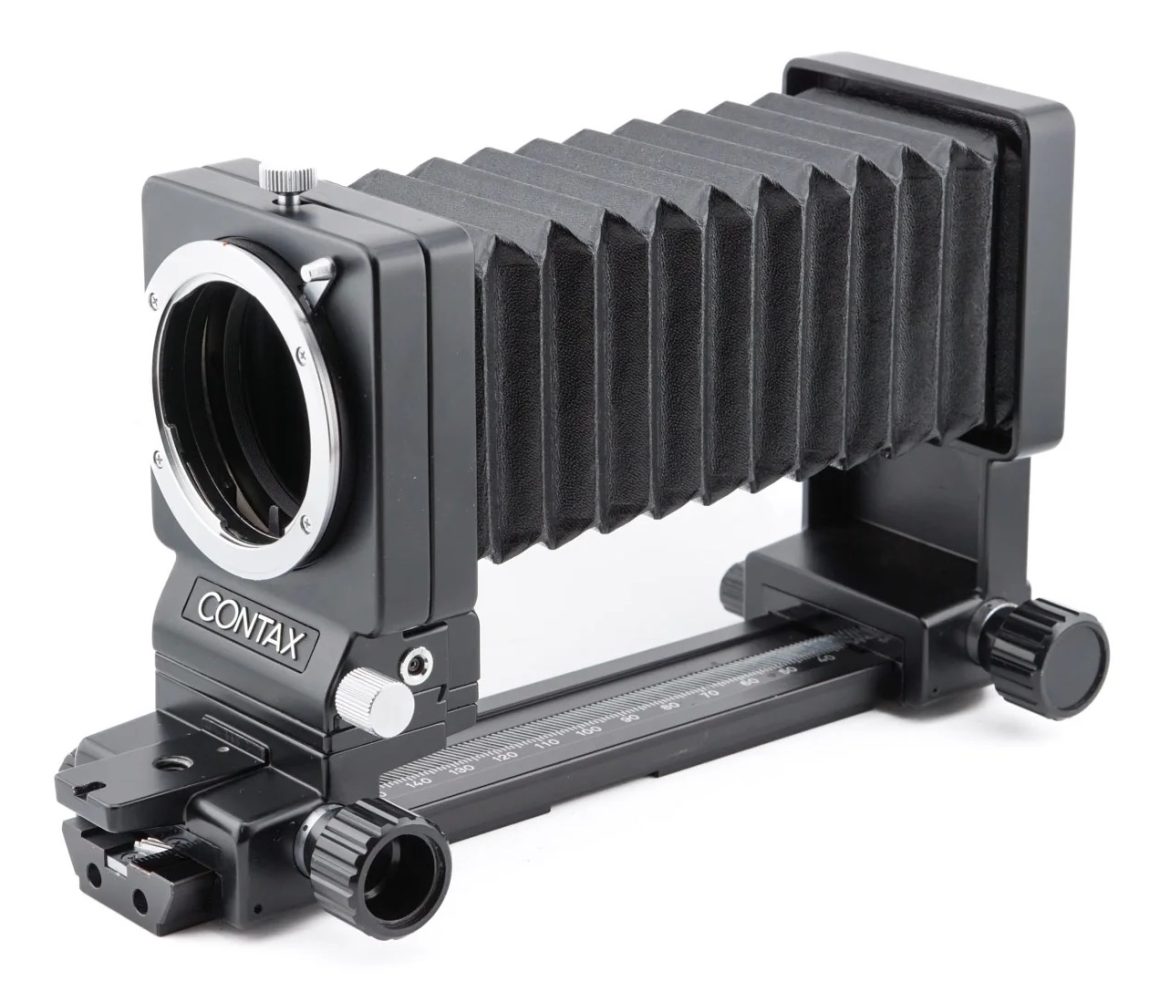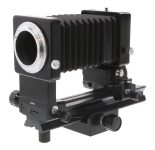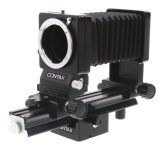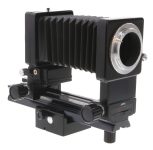Contax Auto Extension Bellows PC
Bellows unit
Manufacturer description #1
The Auto Extension Bellows PC is one of the most advanced of its type available today. Besides the ability to take extreme close-ups at large magnification ratios, this unit also features slide and swing adjustments of the front standard for perspective and depth-of-field control. Essential for sharp photographs at large magnification ratios where the depth-of-field is extremely small. The front standard can also be detached from the bellows section and rotated 360° for reverse-mounting of lenses. A feature which enables larger magnification ratios and sharper photographs.
Manufacturer description #2
A precision attachment offering utmost versatility in close-up and copying work, Auto Extension Bellows assures fully automatic diaphragm action through use of a unique shutter connector cord supplied as standard accessory. It permits full aperture viewing and focusing and affords Real Time stopped-down light reading. In other words, when the cable release attached to the socket on the lens board is depressed, the diaphragm closes down to the preselected aperture and light reading is taken immediately before exposure.
The lens board has provision for horizontal swing for convenience in correcting image distortion. Furthermore, the lens board together with the lens can be detached from the bellows attachment proper and re-mounted in reverse position. When used in concert with the focusing rail available as an optional accessory, precise focus can be secured most readily. The focusing rail can moreover be fixed to the bellows attachment at right angle for horizontal tracking.
- Extends up to 140 mm and features scale with calibration from 0 to 200 mm
- Provides magnification of about 1X to 3X when the standard f/1.4 50 mm lens in use
- Measures 200 X 120 X 70 mm
- Weighs 660 grams
Manufacturer description #3
Bellows attachment featuring full coupling of the lens with the camera body for composition and focusing at full aperture and fully automatic diaphragm action with the aid of the Shutter Connector Cord and exclusive Cable Release. Camera mount can be rotated through 90 degrees permitting positioning the camera in horizontal or vertical posture without detaching it from the bellows attachment. Enables mounting of the lens in either normal or reverse position and has provision for horizontal swing and shift of the lensboard. By using the Focusing Rail, focusing is facilitated and the Macro Stand can be mounted for versatility in close-up and macrophoto work. Set also includes connector cords R-37R for the RTS and R-37S for the Contax RTS II Quartz, 137MA Quartz, 139 Quartz and FX-D Quartz, 52 mm and 55 mm adapter rings and cable release.
- Mount: Contax/Yashica mount
- Light reading: Instant light reading at open aperture.
- Scale readings: 0-200 mm
- Range of extension: 45.5 mm + 140 mm (45.5 to 185.5 mm)
- Lensboard movements: Horizontal shift up to 10 mm to the right and left; horizontal swing through 360 degrees
- Depth-of-field preview: Depth-of-field preview provided through depression of stop-down button on base of lens-board
- Other features: Lens reversing feasible without removing the lens or lensboard; accepts Slide Copier.
- Size: 200 x 120 x 70 mm
- Weight: 785 grams
Contax Focusing Rail
Attaches to the base of the track of the Auto Extension Bellows PC to afford utmost focusing ease. Also enables lateral tracking and permits use of the Macro Stand. Features extra-large focusing knob with locking provision and tripod socket.
- Size: 200 x 34 x 54 mm.
- Weight: 400 grams.
Manufacturer description #4
Auto Bellows PC Set
The most advanced bellows attachment featuring full coupling of the lens to the camera body for close-up photography or slide copying. Complete coupling is achieved via the Shutter Connector Cord (supplied). The Auto Bellows PC has swing and shift capability to correct alignment errors. This bellows, when used with the adapter rings 52mm, 55mm or 67mm (optional) allows the lens to mount in either normal or reversed position.
Auto Bellows PC Set contents: Auto Bellows PC Unit, Connector Cords S37S and R6SJ, Adapter Ring 55mm, Adapter Ring 52mm and Cable Release.
Optional accessories: Focusing Rail, Slide Copy Adapter, Macro Stand, Stage Glasses and Adapter Rin 67mm.
Specifications:
- Mount: CONTAX/YASHICA mount.
- Metering system: Instant exposure reading (Used in concert with cable release and connector cord).
- Lens extension range: 45.5 to 185.5mm.
- Depth-of-Field Verification: Through use of diaphragm stop-down button.
- Swing and shift front: Lens board operation. Shift range: 10mm laterally in each direction (with lock feature). Swing range: 360 degrees (with lock feature).
- Photography in Reverse Position: Full reversal rotation of lens or mounting of lens board in reverse position.
- Camera mount: Revolving camera mount permitting rotation for horizontal or vertical format.
- Lateral Tracking: With aid of Focusing Rail.
- Size: 200(W)x120(H)x70(D)mm.
- Weight: 785grams.
When the Auto Bellows PC is used with the CONTAX S2/S2b, the connector cord is not required. Use a double, mechanical cable relase available on the market.
Focusing Rail
When attached to the Auto Bellows PC the entire camera, bellows and lens assembly moves as a unit to provide fast, accurate focusing.
- Dimensions: 200(W)x34(H)x54(D)mm.
- Weight: 400grams.
Manufacturer description #5
The Auto Bellows System opens a completely new and fascinating world of close-up and macrophotography. It offers unlimited possibility in discovery of wonders all around you through close-ups and/or larger-than-life-size reproduction of objects, such as flowers, insects, stamps and coins.
The Auto Extension Bellows attachment has provision for mounting the camera body on one end and the lens on the other and can be extended or retracted as required to obtain the desired object magnification. The Contax Auto Extension Bellows incorporates a number of unique features. Through use of the Shutter Connector Cord and the cable release supplied as standard accessories, the photographer can take full advantage of the camera's electromagnetic release system and automatic diaphragm action. In short, when the bellows attachment is in use, light reading is taken the moment the lens diaphragm stops down to the pre-selected aperture immediately prior to exposure. The photographer can therefore secure focus and compose the picture always at full aperture regardless of whether the bellows is extended or retracted.
The Contax Auto Extension Bellows moreover features provision for horizontal swing and shift of the lens board. When the swing lock lever is released, the lens board can be turned through 360 degrees on its pivot, thus enabling the photographer to set the lens in reverse position without removing the lens board from the trak or the lens from its mount.
Another major advantage of this bellows attachment lies in the fact that the camera body can be rotated merely by loosening the camera mount thumbscrew, permitting one to position the camera for horizontal or vertical format shooting most readily.
Besides the extension bellows, this Auto Bellows System includes such accessories as the Focusing Rail, Slide Copier and Macro Stand, all designed to extend the scope of close-up photography, macrophotography and copying work. The use of the Focusing Rail in combination with the Auto Extension Bellows affords most convenient focusing. This focusing rail is indispensable in lateral tracking, when taking full advantage of the horizontal swing and shift provision of the bellows and when photographing with the aid of the Macro Stand. In addition to these accessories, the use of the Real Time Winder will certainly assure greater versatility in close-up work. The automatic film drive will eliminate all possiblity of shift in focus due to camera movement in the course of manual film wind, thus permitting sequence shooting and assuring all the advantages of Real Time Photography.




